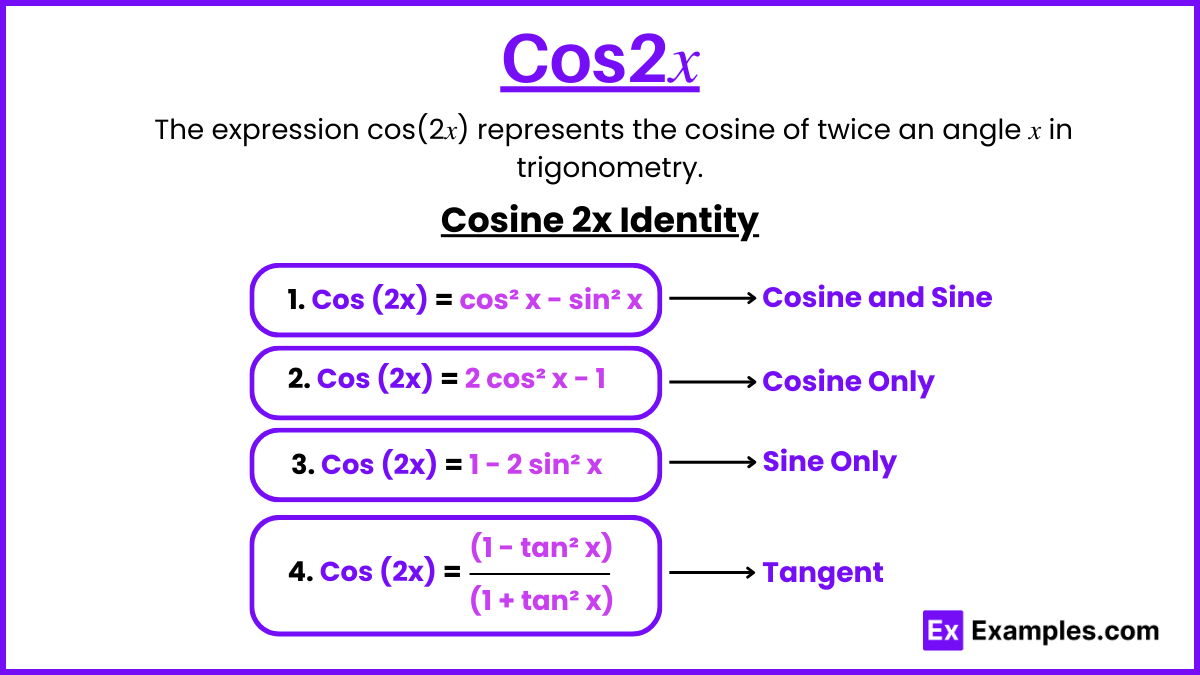If cos(x) = 1/2, what is cos(2x)?
1/4
1/2
0
-1/2


The cos2x identity is an essential trigonometric formula used to find the value of the cosine function for double angles, also known as the double angle identity of the cosine function. This identity helps express the cosine of a compound angle 2x in various ways: in terms of sine and cosine functions, only the cosine function, only the sine function, and only the tangent function. Derived using different trigonometric identities, the cos2x formula can be represented in multiple forms. Additionally, we will explore the concept of cos²x (cos square x) and its formula in detail.
Cos2x, also known as the double angle identity for cosine, is a trigonometric formula that expresses the cosine of a double angle (2x) using various trigonometric functions. It can be represented in multiple forms: cos 2x = cos² x – sin² x, cos 2x = 2 cos² x – 1, cos 2x = 1 – 2 sin² x, and cos 2x = (1 – tan² x) / (1 + tan² x). These identities are derived using the sum of angles formula and Pythagorean identities. The cos2x identity is essential for solving trigonometric equations, simplifying expressions, and analyzing periodic functions, making it a fundamental tool in mathematics and its applications in fields like physics, engineering, and computer science.
Hence, the formula for Cos2x in terms of Sin x is:
Cos2x = 1 – 2Sin²x
Hence, the formula for Cos2x in terms of Cos x is:
Cos2x = 2Cos²x – 1
Hence, the formula for Cos2x in terms of Tan x is:
Cos2x = (1 – Tan²x) / (1 + Tan²x)
Cos2x has a period of π. This means that the function repeats its values every π units. For example, Cos2(x + π) is equal to Cos2x.
Cos2x is an even function, meaning it is symmetric about the y-axis. This implies that Cos2(-x) is equal to Cos2x.
The range of Cos2x is between -1 and 1, inclusive. In other words, Cos2x will always produce values within this interval.
Cos2x has critical points where its derivative is zero. These points occur at x = nπ/2 for integers n. These points correspond to the local maxima and minima of the function.
Cos2x achieves its maximum value of 1 and its minimum value of -1 at specific points:
Cos2x can be expressed in terms of other trigonometric functions:
The double-angle formula for cosine can be expressed using only the cosine function: Cos2x = 2Cos²x – 1
Cos2x can also be written in terms of the sine function: Cos2x = 1 – 2Sin²x
To express Cos2x using the tangent function, we use the identity involving tangent: Cos2x = (1 – Tan²x) / (1 + Tan²x)
Though less common, Cos2x can be related to the secant function as well: Cos2x = (2 – Sec²x) / Sec²x
Cos2x can also be expressed in terms of the cosecant function: Cos2x = (2Csc²x – 1) / Csc²x
Finally, the double-angle formula for cosine can be written using the cotangent function: Cos2x = (Cot²x – 1) / (Cot²x + 1)
Problem 1: Evaluating cos2x given cosx
Question: Given cosx = 1/2, find cos2x
Solution: Using the double-angle formula for cosine: cos2x = 2cos²x−1.
Substitute cosx=1/2:
cos2x = 2 (1/2)² – 1 = 2 (1/4) -1 = 1/2-1 = -1/2
So, cos2x = -1/2
Problem 2: Evaluating cos2x given sinx
Question: Given sinx=√3/2, find cos2x.
Solution: First, use the Pythagorean identity to find cosx: sin²x+cos²x = 1.
So, (√3/2)²+cos²x=1.
This gives 3/4+cos²x = 1, thus cos²x =1/4, meaning cosx=±1/2.
Using cosx = 1/2 or cosx=−1/2:
cos2x = 2(1/2)²−1 = 1/2−1 = −1/2.
So, cos2x = −1/2.
Problem 3: Solving cos2x=0.5
Question: Solve for cos2x = 0.5.
Solution: We know that cos2x=0.5.
This corresponds to: 2x=±π3+2kπ for k∈Z.
Thus: x=±π/6+kπ.
So, the solutions are: x=π/6+kπ or x=−π/6+kπ.
Problem 4: Maximum and Minimum Values of cos2x
Question: What are the maximum and minimum values of cos2x?
Solution: The cosine function oscillates between -1 and 1. Since cos2x is just a cosine function with a different argument, it also oscillates between -1 and 1.
Therefore:
Maximum value of cos2x is 1.
Minimum value of cos2x is -1.
Problem 5: Expressing cos2x in terms of tanx
Question: Express cos2x in terms of tanx
Solution: Using the identity cos2x=1−tan²x/1+tan²x:
We start from the double-angle identity: cos2x = 2cos²x−1.
Using cos²x=1/1+tan²x:
cos2x = 2(1/1+tan²x)−1 = 2/(1+tan²x)−1 = 2−(1+tan²x)/(1+tan²x) = (1−tan²x)/(1+tan²x).
So, cos2x=1−tan²x/1+tan²x.
Text prompt
Add Tone
10 Examples of Public speaking
20 Examples of Gas lighting
If cos(x) = 1/2, what is cos(2x)?
1/4
1/2
0
-1/2
What is cos(2x) if cos(x) = 0?
-1
0
1
1/2
Find cos(2x) if cos(x) = √3/2.
1/2
0
1
-1/2
If cos(x) = −1/2, what is cos(2x)?
0
-1/2
1
-1
What is cos(2x) if cos(x) = 1/√2?
1/2
0
-1
1
Find cos(2x) if cos(x) = 2/3.
1/9
1/3
4/9
7/9
What is cos(2x) if cos(x) =1/4 ?
1/8
1/2
7/8
9/16
If cos(x)=3/5, what is cos(2x)?
2/5
3/5
7/25
9/25
Find cos(2x) if cos(x) = 5/13 ?
14/25
24/25
49/169
120/169
If cos(x) = −1/3 what is cos(2x)?
1/9
5/9
7/9
9/9
Before you leave, take our quick quiz to enhance your learning!

